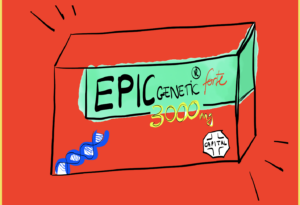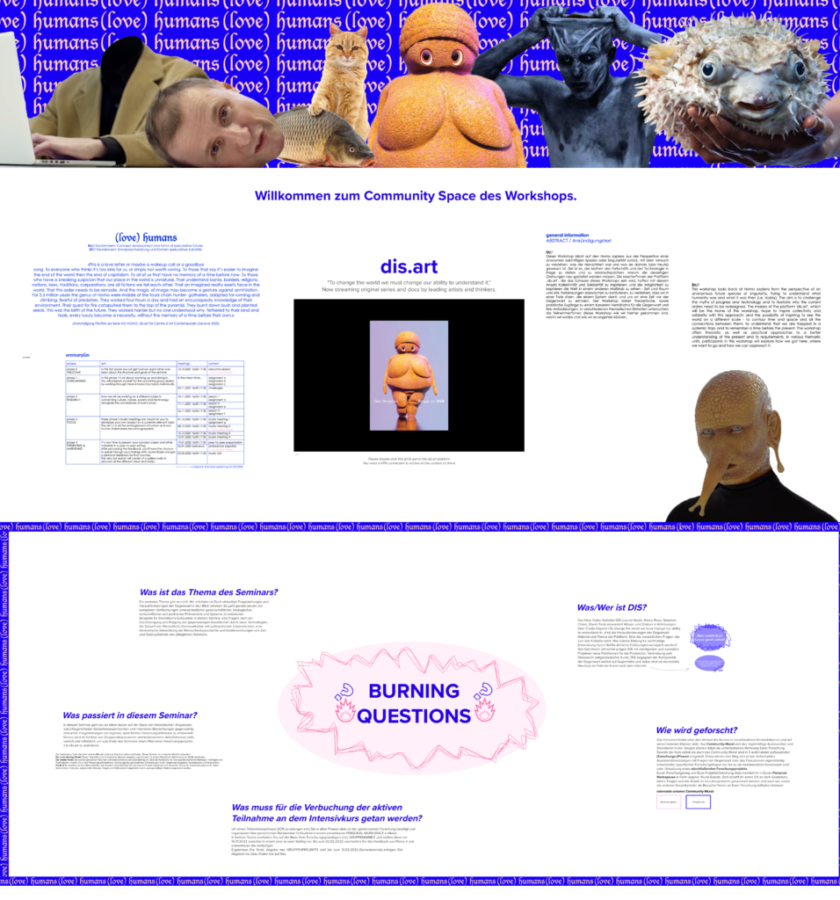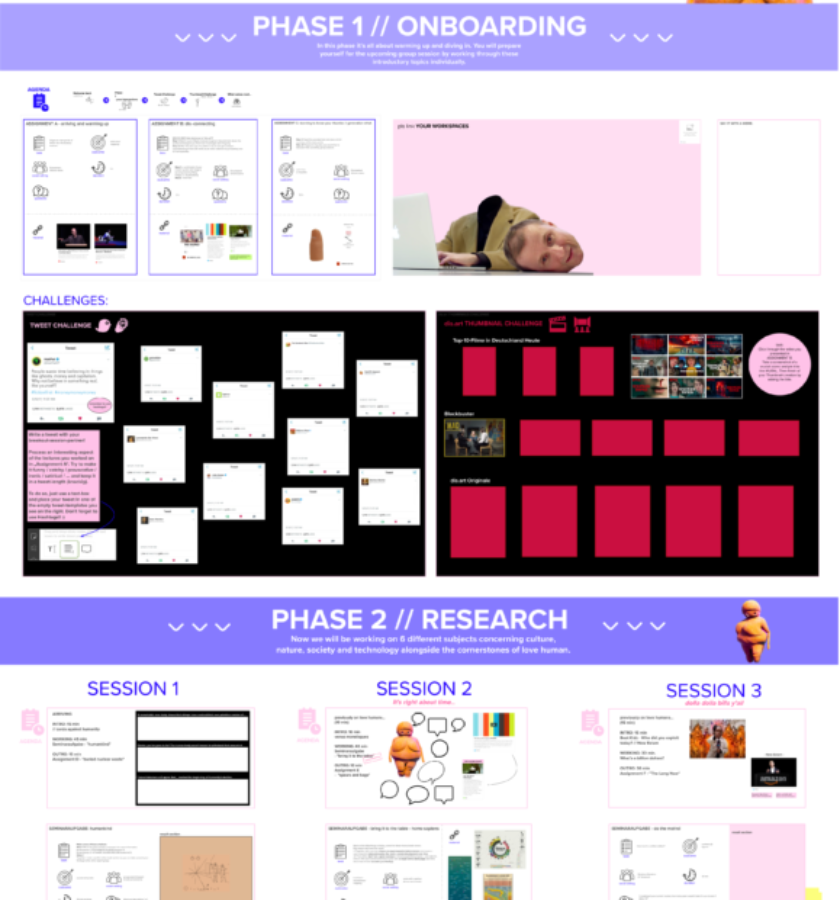
Digitaler Rundgang: LOVE HUMANS
WS21/22
Dozentinnen/Tutorinnen: Konstanze Schütze, Anja Lomparski, Jana Wodicka
Eine konzentrierte Gelegenheit für Begegnungen mit der Komplexität der Gegenwart – auf Augenhöhe.
Der künstlerisch-praktische Intensivkurs „love humans“ wird von Konstanze Schütze und den Tutor*innen Anja Lomparski und Jana Wodicka organisiert und gestaltet und findet in Kooperation mit Lauren Boyle des New Yorker Kollektivs DIS statt. Der Kurs ist darauf ausgelegt forschend-kreative Prozesse in Gang zu setzen, die in der Erstellung recherche-basierter Konzepte für künstlerische Videoarbeiten à la dis.art münden. Entlang der Genre-Non-Conforming-Edutainement Plattform und weiterer theoretischer Inputs werden vielerlei und teilweise sehr kuriose gesellschaftliche, technologische sowie politische Entwicklungen der Gegenwart in den Blick genommen. Dis.art bietet als Streaming-Service audiovisuelle und filmische Kunst, welche sich mit den 4 Vertikalen nature, nations, capital und identity auseinandersetzt. Die Beiträge haben als gegenspekulative Bildungsangebote den Anspruch unterhaltsam und informativ zugleich zu sein. Sie können nicht in konventionelle Kategorien eingeordnet werden. Boyle bezeichnet dies als produktive Unordnung und notwendige Hybridität. Mit den Worten „Simplification is our enemy“, kommentiert sie in Ihrem Vortrag „Thumbs That Type and Swipe – The DIS Edutainement Network“ eine Abbildung mit der Aufschrift „Train yourself in complexity“.
Der kreative Forschungsprozess, welcher in love humans angestoßen wird, ist in fünf wegleitende Phasen eingeteilt, welche sich auch in dem Community-Mural des Kurses manifestieren. Das Community-Mural ist unser Spielplatz, unser Herzstück, unser Schmelztiegel! Für alle Assignments, Challenges, Ideen, Rechercheergebnisse, Fragen und visuellen Ausbrüche funktioniert es als zentraler Sammelplatz. Am spannendsten wird es, wenn dort aus individuellen Recherchen kollektive Projekte werden.
In den Forschungsphasen kommt es zunächst darauf an sich anhand visuell aufgeladener Arbeitsmethoden thematisch in den Kurs einzufühlen und in die Auseinandersetzung mit dem mannigfaltigen Angebot der Plattform dis.art zu kommen. Anschließend geht es um das Beforschen und Diskutieren von Themenfeldern rund um die Zukunft der Menschheit und die Kommunikation mit außerirdischen Lebensformen, sowie um die Betrachtung und Reflexion von Entwürfen nonlinearer Geschichtsschreibung und Größenordnungen von Zeit und Geld jenseits des alltäglichen Vorstellungsvermögens. Ausgehend von der intensiven Beschäftigung mit Entwicklungen und Fragen der Gegenwart wird in der zweiten Hälfte des Intensivkurses kollaborativ an Konzeptpapieren für eigene Edutainment-Projekte (//CONCEPT PAPER) gearbeitet und gefeilt, von denen hier nun eine Auswahl ausgestellt wird.
What if I told you three secrets?
von Antonia Burggraef, Anouk Theißen
What if I told you three secrets that could change your life?
Are you feeling overwhelmed often? Especially confronted with the current state of the world we live in.
Do you sometimes feel like you’re losing control over your life, that you are not in charge anymore?
You are not alone.
Do you think of yourself as a critical mind who wants to learn more about the world and how it works?
Are you open-minded and ready to evolve?
Then I can help you.
What if I told you three secrets that could change your life?
Together we could change the world.
Who wants to smash the patriarchy?
VON Kate Cahill & Ellice Rams
Welcome to the game show “Who wants to smash the patriarchy?”! Sounds like a game to you? Let me give you a brief introduction of how we play it. The goal of the game is pretty simple: You just have to answer the given questions correctly to win money. Sounds easy to you? Then keep reading. In this show the price gets donated to an organization chosen by the participants (and no, you cannot donate it to yourself, no matter how broke you are). This is how it works: Every week, we present a quiz on a certain topic with ten questions. This week the questions will all be about abortion laws and rights. I can already hear all feminists scream and men moan from a distance, but that is the game.
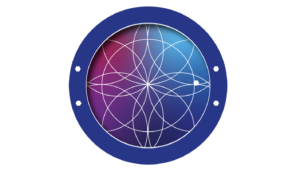
Human Body Movement Advance
VON Lilien Balduin & Phillip Heitmüller
Run. Jump. Climb the rocks. Jump. Running across the woods. Swim. Swim. Very quick. Against the stream. I don’t drown. I have a strong body. I catch the fish in the river. I climb the trees. Reaching branch after branch. Climbing higher. Reaching for the highest fruits. I leave the tree. Jumping back on the ground. The earth absorbs the force of the jump. My body is strong. Perfect harmony.
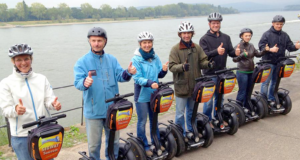
IDENTITY
VON Lilli Karschowski, Chantal Preuß, Emily Adams
What are we except of a skeleton wrapped in flesh with a conscious mind and feelings? We are human beings but what is exactly our identity? How do we define ourselves? What makes us what we are? What differs us from others or are we all the same? What influences our self-perception? Are we enriching ourselves and our surroundings or are we destructive? What consequences follow on our journey of self-discovery?
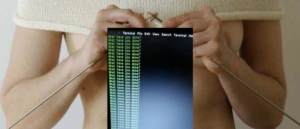
EpiCgenetic
VON Marlène Tencha
Some of us grow small, some grow tall. Some become thin, others fat. Often people have brown eyes, more rarely green. Some play the piano with their long fingers, others need glasses to read. Before we see the light of day, our body has already decided on a certain blood group. Our hair can become red, brown, black or blond and of course a lot of varieties of that. Many traits occur in a wide range of variations and are…genetically inherited.Our genes determine how we look and often what we can do and how. Genetic inheritance is the passing on of genetic information. In humans, this occurs through sexual reproduction.
The approximately 100,000 genes of humans are distribu-ted over 23 pairs of chromosomes, which are located in each cell nucleus. Physical characteristics such as stature, blood type or hair color are inherited. Inherited are also the susceptibility to diseases, the resistance, but also typical behavior patterns such as fearfulness or self-confidence and skills such as craftsmanship or musical talent.
Sounds simple, doesn‘t it?It isn‘t.
